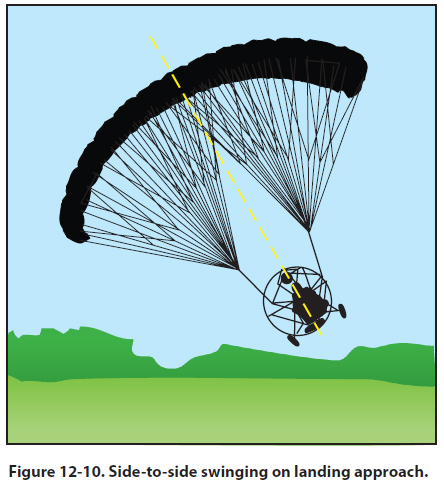|
Chapter 12 — Night, Abnormal, and Emergency Procedures
Gust-Induced Oscillations
Gusty headwinds can induce pitch oscillations as the
lightweight wing responds faster and more easily
to the wind gust than the cart. Crosswinds can also
induce side-to-side swing oscillations. A crosswind
from the right, for instance, tends to weathervane the
PPC wing into the wind, causing an unexpected yaw
to the right. Right crosswind gust also tends to lift
the upwind side of the wing. When crosswinds are
gusty, these effects vary rapidly as the speed of the
crosswind varies.
Local terrain can have a considerable effect on the
wind. Wind blowing over and around obstacles can be
gusty and chaotic. Nearby obstacles, such as buildings,
trees, cliffs, and mountains can have a pronounced effect
on low altitude winds, particularly on the downwind
side of the obstruction. In general, the effect of
an upwind obstacle is the creation of additional turbulence.
These conditions are usually found from the
surface to a height 10 times above the obstacle. Flight
in these conditions should be avoided.
Pilot-induced side-to-side swinging can occur as the
pilot continues to over-control the steering controls.
This usually occurs with new pilots during the landing
phase, and typically begins after a side gust of
wind during the approach. The solution is similar: relax
your steering control pressures; realize the PPC
wants to be centered (side to side, as well as fore and
aft). Ease the pressure on the steering controls, and let
your inputs balance the PPC pendulum movements.
[Figure 12-10]

Cross-Country Flights
Preparation is essential to handling an emergency
while on a cross-country flight. Carry your wing bag
and line sleeve whenever possible. If you have these
items with you during a flight, should you confront
unexpected bad weather, you need not consider going
around it or fighting it. Simply find a suitable landing
site —preferably next to a road. Avoid private property
and landing in crops. Pack up your wing and secure
the canopy bag to the cart any time you are on the ground. You then have the option to wait until the
weather passes or walk to a phone or shelter.
Emergency Equipment and Survival Gear
It is a good idea (especially at a fly-in) to circle a new
flight park before departing, making a note of the local
landmarks, so you can find your field (via pilotage)
on your return. Be sure to file, open, and close a
flight plan with Flight Service (FSS).
Carry a flight safety kit:
• Flashlight.
• Reflection mirror.
• Water and food (enough for 2 days).
• Matches.
• A utility tool: combo pliers, knife, and so forth.
• Your canopy bag and line sleeve whenever
possible just in case you are forced to drive
the cart back to civilization. Note: You should
drive the cart to the nearest phone—BUT NO
FARTHER.
• Tire repair can which includes a sealer and air
pressure.
• Tape to repair small canopy tears.The
manufacturer’s POH typically has specifications
for repairs but as guideline, a tear less than
2" can be repaired with common duct tape.
However, cut lines will ground you and hence
force you to drive the cart back or walk home.
Communication can be your radio, cell phone, visual,
or audible signals. Signal mirrors, flashlight or
light beacons at night, signal fire flames at night, sig-nal smoke during daylight hours, signal flares, and a
prominent wing display are effective methods.
Search and rescue squads (SAR) are particularly
tuned to signals of threes. Hence, three fires arranged
in a triangle, three bangs against a log, or three flashes
of a mirror—all of these will initiate a rapid response
by search and rescue.
The aviation transceiver can be tuned to broadcast and
receive on the emergency frequency 121.5 MHz or
any other usable frequency that will elicit a response.
The wing can be employed to lay out a prominent
marker to aid recognition from the air by other aircraft.
The wing can also be used as an effective
layered garment when wrapped around the body to
conserve body heat or to provide relief from excessive
sunlight.
|

